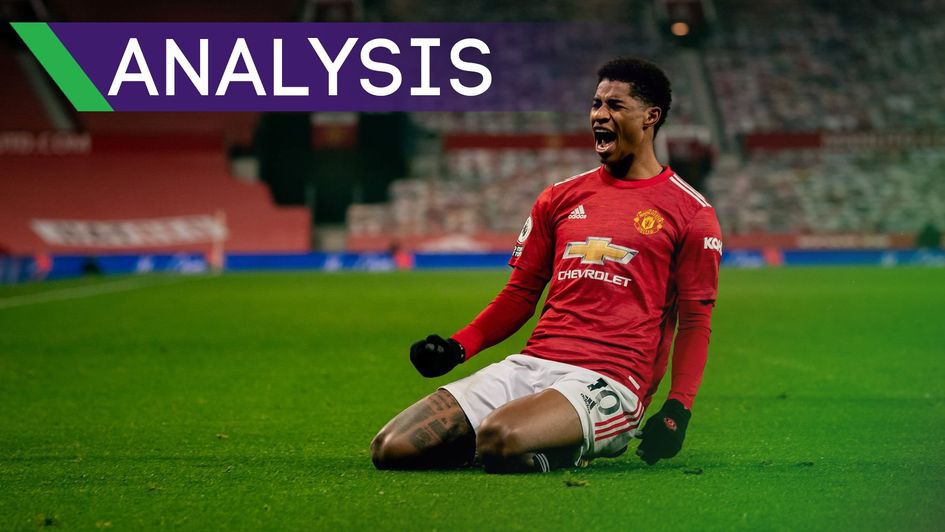Richard Jolly compares Marcus Rashford to his current Manchester United team-mates, and Liverpool's front three ahead of Sunday's top-of-the-table clash at Anfield.
“Even I am proud of him.” Jurgen Klopp had put allegiances to one side, jokingly admitting he was not accustomed to praising Manchester United players. “What Marcus has started is absolutely incredible.”
Klopp was hailing Rashford for his successful campaign to force the government to provide free school meals to children from underprivileged backgrounds. The Mancunian, the German said in October, was “blessed with sensational talent.”
This time, he was talking about football. That sporting assessment was separate from his acclaim for Rashford’s charitable work. It seemed equally heartfelt. Because, more than anyone else in Ole Gunnar Solskjaer’s side, Rashford is the Klopp-style player in the United squad.
Liverpool v Manchester United
Sunday 16:30 GMT on Sky Sports
Match odds: Home 1/1 | Draw 13/5 | Away 13/5
- Marcus Rashford to score and Man Utd to win - 6/1
- Marcus Rashford to score first - 7/1
- Marcus Rashford to score anytime - 13/5
Imagine a world where the Old Trafford scouting system had somehow missed Rashford and where Sadio Mane had eluded Liverpool, where Klopp was looking for a fast, right-footed goalscorer who could play in a narrow role on the left, who could score and had the attitude and energy he liked.
Rashford would surely tick the boxes; indeed, there were times when Rashford’s development stalled under Jose Mourinho when it was tempting to think he would have kicked on under Klopp’s coaching.
He has since progressed under Solskjaer, especially in a Mane-esque role on the left; whereas Mourinho’s wingers spent more time covering their full-backs, the Norwegian’s can be more attacking.
It might seem a rare common denominator.
United and Liverpool, first and second, are the historic enemies who are often defined by their differences. Now they can extend to tactics.
Consider Liverpool’s forward three versus United’s front four. The number is different; so, too, the emphasis. Liverpool have no No. 10; Klopp does not want a Bruno Fernandes equivalent. United have a greater divide between their defensive midfielders and the one attacking member of the three. Klopp tends to look for all-rounders.
In attack, Liverpool have a trio who, even when Diogo Jota was in scoring form, verged on being automatic choices. United have more of a vacancy on the right – if Paul Pogba plays on the left, Rashford could be shifted there on Sunday – and while Mason Greenwood, as a left-footed finisher, has certain similarities with Mohamed Salah, the Egyptian offers far more assists; 10 to one in last season’s Premier League.
If United landed their dream target, they would have a second Klopp-type footballer: Jadon Sancho feels another ideally designed for the German’s tactics, and not merely because he is being schooled at Borussia Dortmund.
Yet the fundamental divergence comes courtesy of an idiosyncratic player. Roberto Firmino is unique, even by the standards of false nines, a player who knits a team together and who Klopp does not judge by his goal tally. In Edinson Cavani, Solskjaer’s Plan B is the more conventional No. 9, a penalty-box poacher who looks the anti-Firmino.
In Anthony Martial, Plan A resembles Rashford, the sort of quick forward designed to suit counter-attacking football. Martial’s finishing is better than is often acknowledged and he dramatically overperformed his Expected Goals (xG) last season, scoring 17 times from an xG of 10.9, but the criticism is that he is often not in the positions to score; Firmino, despite being both more profligate and his work in other areas, posted a higher xG.
A hamstring problem may sideline Martial on Sunday; if so, Cavani and Firmino offer an example of opposites.
So the comparison of near-equals may be Rashford and Mane. While Solskjaer initially installed Rashford as his main striker with Martial on the left and swapped them over at the start of last season; the Englishman’s subsequent outings in central roles have often come when the Frenchman has been absent.
And they have posted similar figures over that time, and not just because each has scored 24 league goals.
Mane has averaged 1.18 and then 1.35 shots on target per 90 minutes, Rashford 1.29 and then 1.25. Each has directed between 41 and 47% of his shots on target.
Rashford's non-penalty xG per game was 0.38 last season and it is 0.39 this. Mane’s are higher, at 0.45 and 0.52 respectively, perhaps a consequence of Klopp’s tactics getting him into more scoring positions.
Liverpool’s higher-intensity pressing game is illustrated by the fact that Salah, Firmino and Mane all rank in the division’s top seven for pressures in the final third. Rashford was 39th last season and is 29th this, speaking to United’s preference for the counter-attack instead of gegenpressing.
It is an insight into different tactics. The similarity lies in their attacking output.
Since the start of last season, Mane has had 124 shots in the Premier League, Rashford 127. In 2019-20, both ended up averaging 0.82 goals and assists per 90 minutes. It was an identical outcome for players with similar skillsets.
It is why, apart from when he is trying to beat Liverpool, Rashford should have an admirer in Klopp.
Follow Sporting Life on social - find us on Facebook here or tweet @SportingLifeFC
Related football content
- Transfer window: Done deals
- Transfer window: Latest updates
- Latest football previews and tips
- Sporting Life App: Android & iOS
Responsible gambling
We are committed in our support of responsible gambling. Recommended bets are advised to over-18s and we strongly encourage readers to wager only what they can afford to lose.
If you are concerned about your gambling, please call the National Gambling Helpline on 0808 8020 133, or visit begambleaware.org.
Further support and information can be found at GamCare and gamblingtherapy.org.


